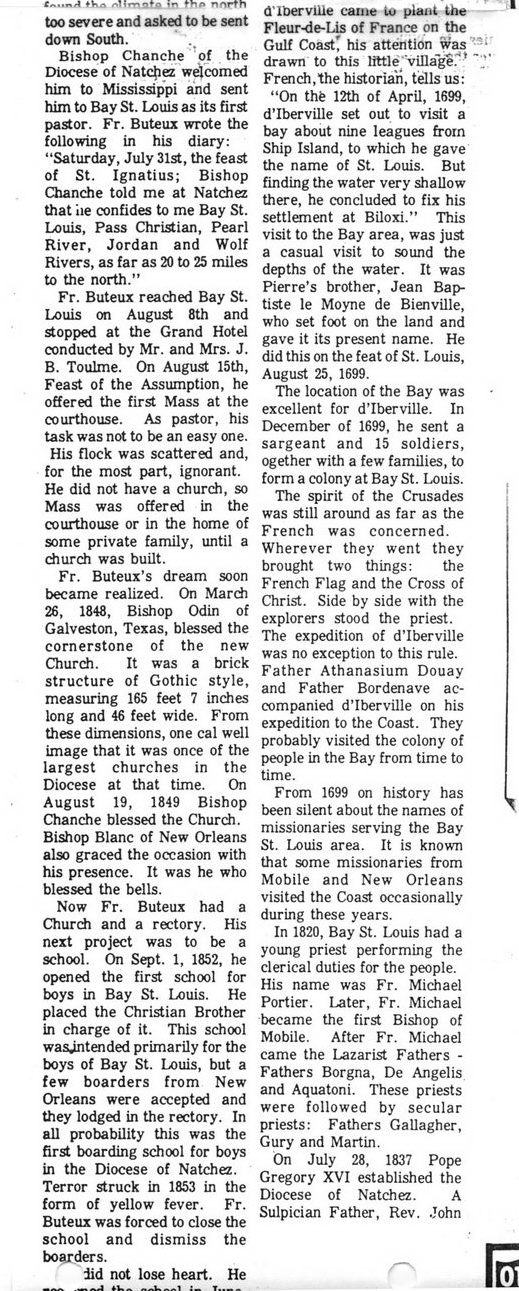This text was obtained via automated optical character recognition.
It has not been edited and may therefore contain several errors.
too severe and asked to be sent down South. Bishop Chanche of the Diocese of Natchez welcomed him to Mississippi and sent him to Bay St. Louis as its first pastor. Fr. Buteux wrote the following in his diary: ?Saturday, July 31st, the feast of St. Ignatius; Bishop Chanche told me at Natchez that iie confides to me Bay St. Louis, Pass Christian, Pearl River, Jordan and Wolf Rivers, as far as 20 to 25 miles to the north.? Fr. Buteux reached Bay St. Louis on August 8th and stopped at the Grand Hotel conducted by Mr. and Mrs. J. B. Toulme. On August 15th, Feast of the Assumption, he offered the first Mass at the courthouse. As pastor, his task was not to be an easy one. His flock was scattered and, for the most part, ignorant. He did not have a church, so Mass was offered in the courthouse or in the home of some private family, until a church was built. Fr. Buteux?s dream soon became realized. On March 26, 1848, Bishop Odin of Galveston, Texas, blessed the cornerstone of the new Church. It was a brick structure of Gothic style, measuring 165 feet 7 inches long and 46 feet wide. From these dimensions, one cal well image that it was once of the largest churches in the Diocese at that time. On August 19, 1849 Bishop Chanche blessed the Church. Bishop Blanc of New Orleans also graced the occasion with his presence. It was he who blessed the bells. Now Fr. Buteux had a Church and a rectory. His next project was to be a school. On Sept. 1, 1852, he opened the first school for boys in Bay St. Louis. He placed the Christian Brother in charge of it. This school wasjntended primarily for the boys of Bay St. Louis, but a few boarders from New Orleans were accepted and they lodged in the rectory. In all probability this was the first boarding school for boys in the Diocese of Natchez. Terror struck in 1853 in the form of yellow fever. Fr. Buteux was forced to close the school and dismiss the boarders. did not lose heart. He ?______________UT___________ d?i'Dervuie came to plant the Fleur-de-Lis of France on the Gulf Coast? his attention was drawn to this little?'village.?* * French,the historian, tells us: ?On thfe 12th of April, 1699, d?Iberville set out to visit a bay about nine leagues from Ship Island, to which he gave the name of St. Louis. But finding the water very shallow there, he concluded to fix his settlement at Biloxi.? This visit to the Bay area, was just a casual visit to sound the depths of the water. It was Pierre?s brother, Jean Baptiste le Moyne de Bienville, who set foot on the land and gave it its present name. He did this on the feat of St. Louis, August 25, 1699. The location of the Bay was excellent for d?Iberville. In December of 1699, he sent a sargeant and 15 soldiers, ogether with a few families, to form a colony at Bay St. Louis. The spirit of the Crusades was still around as far as the French was concerned. Wherever they went they brought two things: the French Flag and the Cross of Christ. Side by side with the explorers stood the priest. The expedition of d?Iberville was no exception to this rule. Father Athanasium Douay and Father Bordenave accompanied d?Iberville on his expedition to the Coast. They probably visited the colony of people in the Bay from time to time. From 1699 on history has been silent about the names of missionaries serving the Bay St. Louis area. It is known that some missionaries from Mobile and New Orleans visited the Coast occasionally during these years. In 1820, Bay St. Louis had a young priest performing the clerical duties for the people. His name was Fr. Michael Portier. Later, Fr. Michael became the first Bishop of Mobile. After Fr. Michael came the Lazarist Fathers -Fathers Borgna, De Angelis and Aquatoni. These priests were followed by secular priests: Fathers Gallagher, Gury and Martin. On July 28, 1837 Pope Gregory XVI established the Diocese of Natchez. A Sulpician Father, Rev. John

Baxter, Lionel Echo-5-9-77-pg2